Podcast
Questions and Answers
What type of deposits are formed by hot, metal-rich fluids left by magma?
What type of deposits are formed by hot, metal-rich fluids left by magma?
- Non-metallic deposits
- Placer deposits
- Hydrothermal deposits (correct)
- Sedimentary deposits
Which of the following are considered metallic mineral resources? (Select all that apply)
Which of the following are considered metallic mineral resources? (Select all that apply)
- Silver (correct)
- Gypsum
- Marble
- Copper (correct)
Coal is a non-metallic mineral.
Coal is a non-metallic mineral.
False (B)
What is petroleum commonly refined into?
What is petroleum commonly refined into?
Natural gas is primarily composed of ______.
Natural gas is primarily composed of ______.
What is a primary use of natural gas?
What is a primary use of natural gas?
Match the following non-metallic mineral resources with their uses:
Match the following non-metallic mineral resources with their uses:
What is a mineral?
What is a mineral?
Which of the following groups of minerals contains silicon-oxide (SiO4)?
Which of the following groups of minerals contains silicon-oxide (SiO4)?
What process involves the cooling of molten rock to form igneous rocks?
What process involves the cooling of molten rock to form igneous rocks?
Sedimentary rocks are formed from the compaction and cementation of _____ (clasts, minerals, or fossils).
Sedimentary rocks are formed from the compaction and cementation of _____ (clasts, minerals, or fossils).
What is the Mohs scale used for?
What is the Mohs scale used for?
Igneous rocks can only form from lava on the Earth's surface.
Igneous rocks can only form from lava on the Earth's surface.
Metamorphic rocks are formed through heat and pressure.
Metamorphic rocks are formed through heat and pressure.
Match the following mineral groups with their compositions:
Match the following mineral groups with their compositions:
How are sedimentary rocks primarily formed?
How are sedimentary rocks primarily formed?
What characterizes foliated metamorphic rocks?
What characterizes foliated metamorphic rocks?
Which of the following is NOT a process of mineral formation?
Which of the following is NOT a process of mineral formation?
Flashcards are hidden until you start studying
Study Notes
Minerals
- Natural, inorganic solids with a definitive chemical composition and ordered internal structure.
- Composed of single elements (e.g., gold) or multiple elements bound by electrical forces.
- Common ions in minerals include silicon (Si) and oxygen (O).
How Minerals are Formed
- Crystallization from Magma: Cooling molten rock forms minerals.
- Precipitation: Dissolved substances in water react to create minerals.
- Temperature and Pressure Changes: Lead to the formation of new minerals.
- Hydrothermal Solutions: Hot solutions chemically react with existing minerals to form new ones.
Mineral Groups
- Silicates: Most common rock-forming minerals containing silicon-oxide (SiO4).
- Oxides: Metals bonded to oxygen.
- Sulfides: Metals bonded to sulfide.
- Sulfates: Metals bonded to sulfate anions (SO4).
- Halides: Containing halogen ions (F or Cl).
- Carbonates: Contain carbonic ions (CO3).
- Native Metals: Composed of a single metal element.
Common Minerals
- Silicates form the silicon-oxygen tetrahedron and are abundant in Earth's crust.
- Carbonates combine carbon and oxygen with metallic elements.
- Oxides consist of oxygen with one or more metal elements.
- Sulfates and sulfides contain sulfur; halides include halogen ions.
Properties of Minerals
- Luster: Reflectivity of light from the surface.
- Streak: Color in powdered form.
- Hardness: Measured using the Mohs scale (1-10), indicating resistance to scratching.
- Cleavage: Tendency to break along flat surfaces; fracture refers to uneven breakage.
- Crystal Form: Reflects internal arrangement of atoms.
Rocks and Their Formation
- Rocks are aggregates of minerals or solid materials.
- Igneous Rocks: Formed from cooling of magma or lava; texture depends on cooling rate (coarse for slow, fine for rapid).
- Sedimentary Rocks: Formed from compaction and cementation of sediments; include clastic, chemical, and organic types.
- Metamorphic Rocks: Formed through heat and pressure altering existing rocks; classified as foliated (layered) or non-foliated.
The Rock Cycle
- Rock cycle involves transformation between igneous, sedimentary, and metamorphic rocks through processes like cooling, compaction, and exposure to heat/pressure.
- External processes like weathering and erosion are driven by solar energy and gravity to produce sediment.
Earth's Mineral Resources
- Renewable vs. Nonrenewable: Renewable resources replenish quickly; nonrenewable take millions of years. Coal, oil, and natural gas are examples of nonrenewable resources.
- Ore: A profitable metallic mineral; extraction occurs through mining.
- Metallic Minerals: Includes gold, copper, and platinum, often produced through igneous processes.
- Non-metallic Resources: Include limestone, gypsum, and salt, used for construction and manufacturing.
- Fossil Fuels: Coal is carbon-rich; petroleum forms from ancient organic matter; natural gas is primarily methane, produced under intense heat and pressure.
Studying That Suits You
Use AI to generate personalized quizzes and flashcards to suit your learning preferences.




